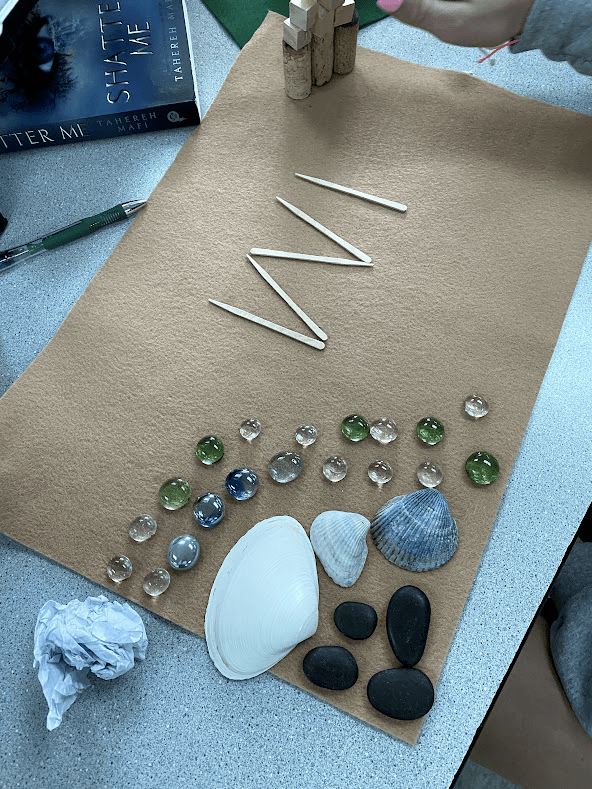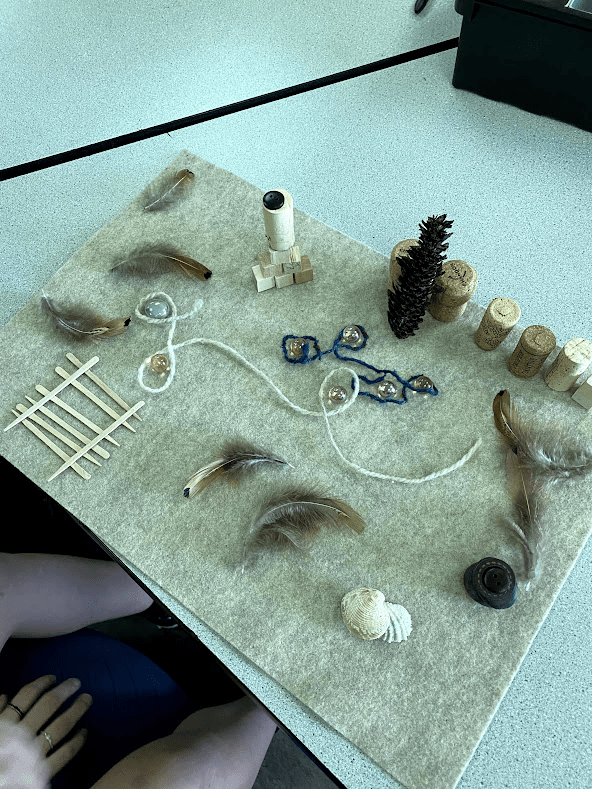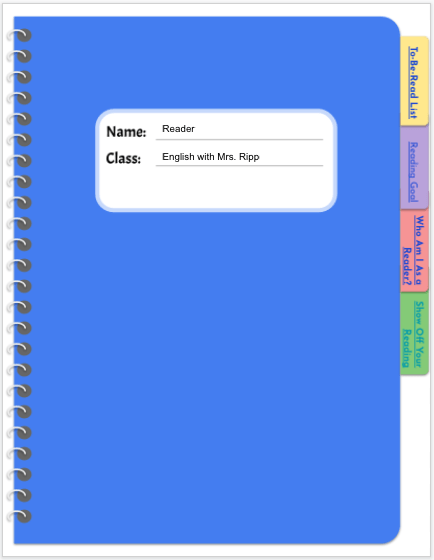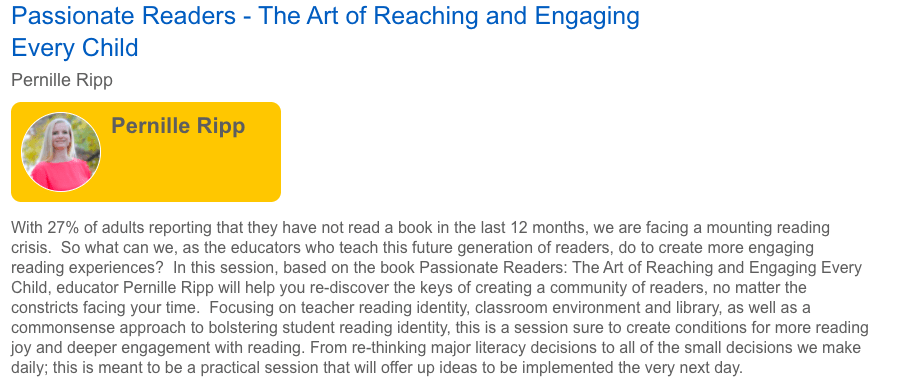I wrote this blog post last year, what follows is an updated version of it in case you are interested in loose parts or storytelling kits with older students. Scroll down to see the update.
A few years ago I traveled to do a day of learning with passionate educators in Maple Ridge/Pitt Meadows in British Columbia. After flight cancellations and changes in airports, Denise Upton, one of the district’s helping teachers, graciously agreed to pick me up and take care of me during the stay. While together, she told me excitedly about Story Workshop, oral storytelling grounded within playful literacy, that they were doing with children as part of their literacy approach. She shared all of the work that they did with students in order to give them natural materials to manipulate and create stories with before they ever sat down to write. She spoke of Indigenous oral storytelling traditions and how they were working on bringing the rich traditions of the peoples’ whose land their school buildings sat on and whose tribal members were within their school population back into the classrooms as a way to honor, teach, and preserve a broader envisioning of writing I was inspired and intrigued. Particularly, after she told me how they were using these material kits with their upper grade levels as well and that the response they had was incredibly positive. After a whirlwind visit, the idea sat in the back of my mind for a while, hoping to someday become something I wanted to do with my own 7th graders.
Well, after a year of teaching unlike any other, after too much screen and not enough togetherness. After once again teaching kids who repeatedly told me how much they hated writing, how writing was so hard, whose sentences were forced across the pages, I decided that someday was now. With a commitment to reconsider every unit and every idea we build our classroom learning on, taking our writing in a much more tactile and playful direction was exactly what I need right now to get excited about next school year. Hopefully, my incoming students will think so as well.
So with a loose idea of what it was Denise had shared with me, the seeds started to grow; what if I build some oral storytelling kits for kids to use in partnerships, trios, or by themselves before we begin to write? What if I collect natural materials for them to manipulate and play with as they share stories from their own lives and also from their imaginations? Surely someone had done this before?
The answer is yes, many have! None of my ideas shared here are really original but I got so many questions on social media when I shared the kits I was building that I figured a blog post would be nice. If you are learning about Indigenous storytelling, there are so many wonderful resources shared, such as this one. If you google “Loose Parts”, you can see a lot of information. If you follow the work of Angela Stockman, she has been sharing so many ideas for years and is truly inspirational. If you are trained within Montessori, you know this work. If you know Reggio Emilia principles, then you know these ideas. If you have worked with younger grades, you probably do this already. There are so many resources out there, so dig in and learn.
My purpose for these kits is to get kids talking more before they write out stories, whether they be stories from their own lives or stories they invent. I want them to build scenes or entire stories together or individually depending on the exploration we are doing. I want them to play with their imagination and ot be forced into written production as quickly as we have done in the past, I want them to build community through story, I want them use their hands more. I want English to have more joy and I want it to authentically fit into the identity-centered work we already do in our literacy explorations.
Building the Kits
I had a million ideas right away and needed a way to ground them so I started by focusing on ideas for what to put in them and also building the kits to give me a more tangible sense of what it would look like. I hate so much that educators are almost always forced to purchase things out of their own pocket, so I spent school budget money to purchase the toolboxes. I bought two different kinds, five altogether, so that I can share them between tables – I typically teach 28 students at a time, so I wanted to make sure that I had enough kits to share materials between 10 different groups if need be. I also needed the kits to not take up too much space in our classroom, be easy to store and move, as well as have different size compartments. The first kind I bought was this one and the second kind was this one.
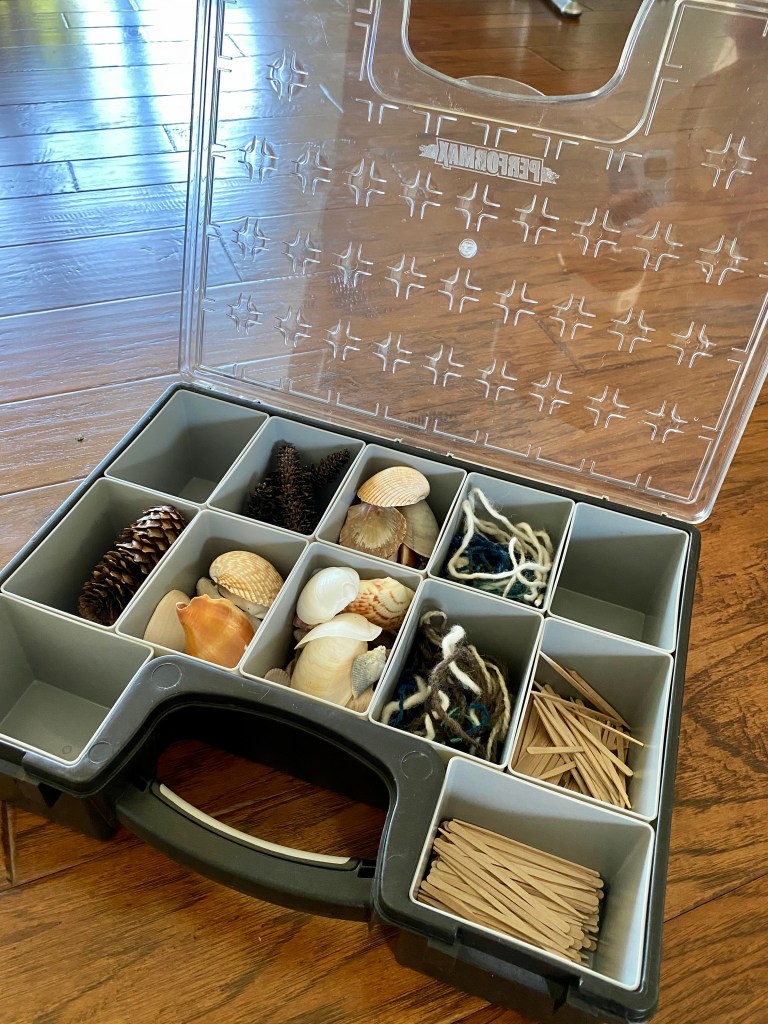
All the boxes are removable in both kits so we can spread them out on the different tables as needed.
Once I had the boxes, then I got more serious with my materials. I had a few guidelines I wanted to follow:
- Natural materials whenever possible
- Different sizes of things to use
- Material that doesn’t necessarily look like “one” thing in order for them to be used for many things
- Low cost and easy to replace
Then I wrote a list, there are so many lists floating on the internet but I posted mine to Instagram and got even more ideas as well as a huge “Duh!” moment. Notice on my original list, I have nuts on it. That is not going to work at all for some of my students due to their allergies. After a helpful educator made me see the light, I updated my original list.
I knew that if I felt like spending a ton of money, I easily could just order all of these things but I don’t want to. So, instead I turned to my local Buy Nothing Facebook group and asked if anyone had any materials they could donate. So what you are looking at in the kits above, almost everything is donated from kind strangers or friends who happened to have materials lying around. Amazing!
So right now in the kits I have:
- Seashells, all sorts, all sizes.
- Pine cones – I need to gather more.
- Small popsicle sticks – they are pointy and I don’t know if I love that.
- Wine corks that do not have wine labels on them.
- Small cork buttons.
- Wood buttons – I bought a giant bag off the internet.
- Wool yarn in different colors – I have cut lengths of string in a variety of lengths.
- White rocks.
- Feathers – I think I may add more of these.
- Glass beads.
- Slices of wood.
I also purchased felt mats in green, gray, and brown for the kids to use as a background. They can use more than one if we have enough left over, again I went with natural tones as a way to center us in nature even if the story takes place in a different setting.
Things I would still like to add:
- Beach pebbles for more color
- More cork
- Cinnamon sticks
- Acorns
- Large popsicle sticks
Ideas for use
So while the kits themselves are a lovely work in progress and bring me happiness right now as I plan, what matters more than the stuff in them is making space for them to be used with our students. So as I planned for the first two weeks of instruction (I do this in order to be able to walk away for a while, not because I want to work all summer), I planned with the kits in mind.
My two-week plan can be viewed here, but please know that it is so much a work in progress, that some of the ideas in it are my own, and others are based on the incredible work others have kindly shared, and that I have given credit to those whose work I am borrowing from or copying. Please feel free to also borrow or use my ideas, just give credit. The kits will be utilized, hopefully, on the third day of school in an activity where students continue to think of the stories they carry and start to build scenes from their own lives that they then, in turn, share with their peers at their tables. After their initial appearance, they will continue to be integrated into our work as we start our first longer writing exploration; personal narrative. Students can use events from their own lives or springboard events from their own lives into a fictional story.
I also want us to think of how the kits may help us work within the emotions we have tied up with our writing, how we can use them to go deeper into story and how stories can weave us together even when we don’t see eye to eye. I am hoping that as we explore our own identities and how that makes us view and react to others, these tangible items will ground us and make us feel safer within our burgeoning community. I am hoping that having these tactile explorations will bring more playfulness into our classroom, as well as more joy. We will also create expectations of how to use the kits with each other. My main focus for that is to be respectful of the material and of what is shared within their stories, but I will ask the students to also think of how to use the materials, how to clean up in order to preserve the kits, and how to work together. It really all ties into the community work we do throughout the year.
My own children helped me eagerly build the kits and have since then also used them. It has been amazing to see them build scenes, stories, and whole worlds using just these materials and then walking me through their stories that they now see so clearly. Even my son who has repeatedly that he hates writing has been using the kits and telling me his stories. I hope I will see the same willingness to try in my 7th graders.
Update
I rolled these kits out with students a few times and the results were mixed. Some LOVED them and jumped right in building scenes, drafting stories, and using them to get their imagination flowing. Others not so much, they played with the materials after a while and built embankments and such (yes, even in 7th grade). But you know what, that actually makes sense to me; some kids will love storytelling this way, others will not. Much like we explore different ways to draft, this then became another choice for it.
And for some kids they allowed a freedom they hadn’t felt in a while as they sat in front of screens, so as I think of rolling them out next year; they will be a choice, not a force as so many other things are in our classroom. Not meant to be yet another way to force kids into a specific mold of what a writer is, but instead offering them ways to discover how they write best. How they would like to play with words and story. I will also dive a little further into how we care for the materials, most were kind to the things, a few had to be reminded. That all comes down to the make up of our classes and the energy the students bring into our space.
Ideas for use
A few ways you can use kits like these:
- Draft your story, scene, or storyline
- Poetry creation
- Introduce yourself
- Partner story creating
- Summarizing a read-aloud, article, or other media
- Create scenes to then act out
- One child creates a scene, the other writes the story without knowing what is but just based off of the components shown
Even with mixed success, they are still exciting to me. They offer us more hands-on opportunities, more ways to use oral storytelling before jumping into typing or handwriting, and also offer us a way to create build community; stories bind us together and trusting each other with our stories is powerful.
I am excited to be heading out on the road again to be with other educators in-district or at conferences, while continuing my virtual consulting and speaking as well. If you would like me to be a part of your professional development, please reach out. I am here to help. For a lot more posts, resources, live and recorded professional development, please join my Patreon community where most of my sharing takes place these days.

